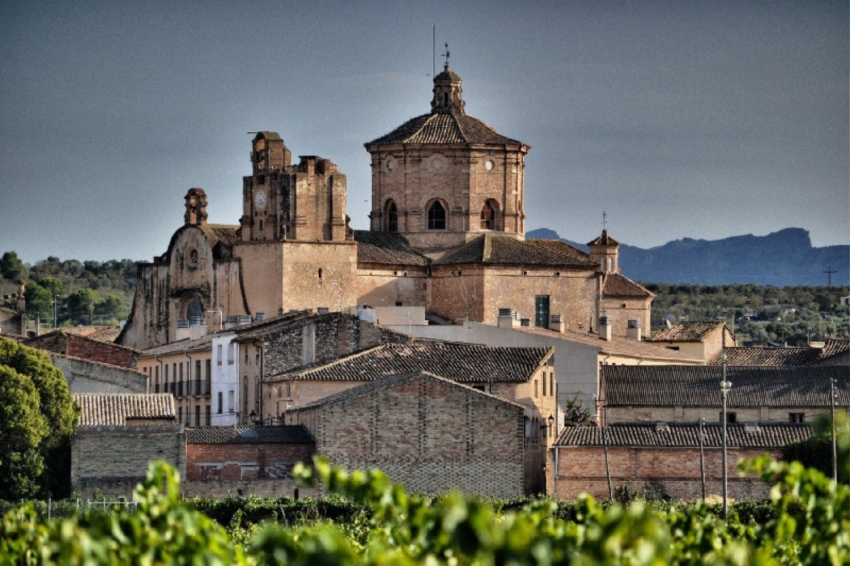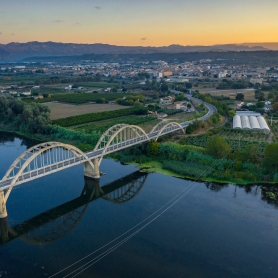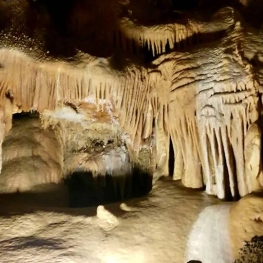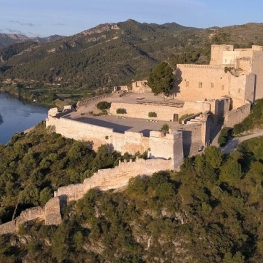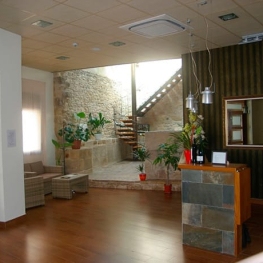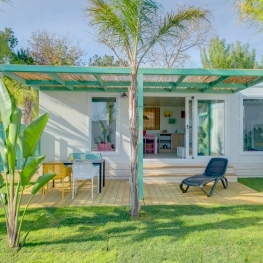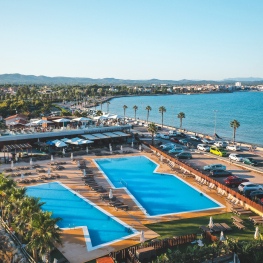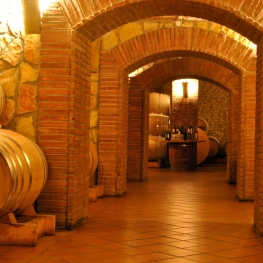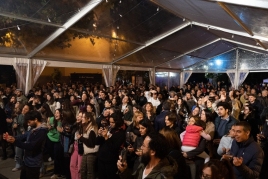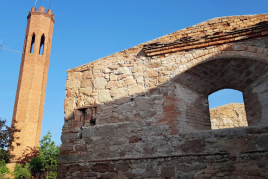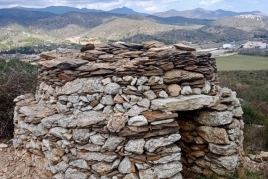Ginestar
Situation and presentation
The term of Ginestar, of an extension of 15.86 km 2, is located in the southern half of the region, to the left of the Ebro, river that makes limit of tramontana with the term of Benissanet. At Levante and noon it ends with Tivissa, and the western sector with Rasquera (to the SW the border follows the irregular course of the stream of the Count) and Miravet (to the NW the cairn, which passes through the left bank of the Ebro, excludes from Ginestar the Sand bank said the Island, left by the river). The territory is part of Mora's basin or depression, since it is located in the southern part. The NW sector is part of the riverine orchard, while a strip along the eastern band, and the SE, corresponds to the last elevations of the Sierra de la Cruz, the most rugged sector is within the neighboring municipality of Tivissa. The landmark with this passes through a line of altitudes between 167 and 120 m, a line that is crossed by several ancient roads: the one of Ginestar in Tivissa, the one of the Almond, the one of Biscorn and others. The territory is crossed by several ravines, of short and irregular layout, among which the Gafolls ravine, the one of the Commons and the one of San Antonio stand out.
The town of Ginestar, head of municipality, is the only nucleus of population grouped of the term, that also includes the hermitage of San Isidro. The road crosses the C-12 between Amposta and Lleida, which follows the route of the Ebro and upstream, at the level of Móra la Nova, links with the N-420 Tar-ragona in Gandesa. In the sector where this road passes closer to the river, there is a ferry crossing to the Islets, from where a road leads to Miravet, and from there to Benissanet and Pinell de Brai.
The site of Ginestar, conquered in the days of Ramón Berenguer IV, in the middle of century XIII, belonged to the dominions of the templarios and the request of Miravet. The Templars granted the then-named, but of Ginestar a town card in 1206. When the Templars, Ginestar, and other possessions of the order were suppressed, they passed to the Hospitallers. The place, which in the thirteenth century was affected by the fighting between the Templars and the Entença, throughout history has suffered several floods of the Ebro. Especially remember those of the years 1617, 1787 and 1907. The city, near Of the battle front of the battle of the Ebro, suffered force damages in 1938.
Population and the economy
The first census of population (ginesterols or ginesterals) dates from 1553, since previously they were included in the global figures of houses ta-cha-from the castlania of Amposta, hospital. This year there were 78 fires. In 1718 there were 210 h. Throughout this century and the next, of a great agrarian prosperity mainly thanks to the vineyard, the demography increased considerably. In 1860 there were 1,292 h for the whole term, most of them in the town. The 1900 census registered 1,715, including that of 1936 in the count of 1,532, a figure that marks the beginning of a continued demographic decline. In 1940 there were 1,426 there were 1,408 in 1950. In 1970 there were 1,098 h, in 1981 there were 948 and 884 in 1991. By 2001 the population had dropped to 835 h, but in 2005 the population grew to 950 h.
The traditional dedication and the base of the economy of the term is the agriculture, predominantly dry land, although part of the population moves to work in the industries and services of municipalities like Mora de Ebro or Mora la Nova and works part time land. The main crop is the olive tree, followed by the almond tree and the vine. Irrigated extensions have been strengthened, focusing on the cultivation of fruit trees, mainly peach trees and pear trees. The poultry represents the most developed cattle sector, followed by the pig. Some flocks of goats and sheep are kept. The Agricultural Cooperative of Ginestar, founded in 1918 and with a rural box created in 1965, sells oil, wine and fruit, along with other private family businesses. Some farmers on the island of Putxó are affiliated with FARE (Associated fruit growers of the Ribera del Ebro).
There are small companies in the agri-food sector, lighting and construction. It is traditional although the crafts of the cane (manufacture of baskets). In other times also was the pottery, that has been disappearing. There is weekly market on Friday.
The town of Ginestar
The town of Ginestar (26 m altitude), is before the sand bank left by the Ebro and called the Island. The old town is where the streets of San Antonio, Borró, Nueva and Calle Ancha converge. Is the town hall. In the center of the city rises the parish church of San Martín, building of the XVIII century of three naves, with dome on the cruiser and bell tower of unfinished tower. Within the nucleus still remains, very deteriorated, the old parochial church of a ship covered with vault followed pointed and of irregular layout.
Ginestar celebrates the great party for San Martín, the second Sunday of November. Other fiestas of the town are San Isidro, May 15, during which the day is spent in the hermitage dedicated to this saint, making a meal of brotherhood.
Other places in the term
Near the village, at noon, is the hermitage of San Isidro, dated in 1617, of a nave covered with dome of lunetos between arches torales and chapels between the buttresses. The whole interior is decorated with murals from the late 18th century with ornamental themes. Near the western limit are the ruins of the hermitage of San Vicente.
Less than a kilometer to the SE of the town of Ginestar, to the right of Gàfols ravine, near the place where it drains in the Ebro is an important archaeological site in which has been discovered the structure of a small town formed by A minimum of 13 enclosures separated by 3 streets of rectilinear layout, with a construction technique that allows dating the deposit between 590/580 BC.
At the boundary with Rasquera, at the Luertes, near the stream of the Count, there is another important surface deposit of prehistoric lytic industries, a deposit that also extends to the neighboring term of Rasquera where it receives the name, by the heading where Found, of the Stones. To Ginestar there is a Roman tablet of the second century, with an inscription. It is preserved in the Municipal Museum of Tortosa.
Source: Gran Enciclopedia Catalana
Nearby routes
See all routes »- Water and life through the Ebro by… (a 3.1 km)
- Route of the castles in Catalonia (a 3.1 km)
- Grand Tour de Catalunya - Section 2.… (a 3.1 km)
- Inside the Ebro river (a 3.1 km)
- 3 routes through some of the most beautiful… (a 3.1 km)
What to do
Coves de Benifallet
Benifallet (a 14.6 Km)One of the best-known tourist options throughout the territory, made up of…
Celler Masroig
El Masroig (a 12.4 Km)Celler Masroig opens its doors to you and reveals its secrets through…
Castell de Miravet
Miravet (a 3.5 Km)The Miravet Medieval Castle is a remarkable example of the architecture of…
Where to eat
Restaurant Hotel Nou Moderno
Vilalba dels Arcs (a 20.8 Km)Hotel restaurant to enjoy the tranquility of Terra Alta and try the…
Where to sleep
Càmping Resort Alannia Els Prats
Mont-roig del Camp (a 29.1 Km)Located in Miami Platja, Tarragona, this is the ideal place to spend…
Hotel Celler Buil & Giné
Gratallops (a 21.6 Km)A unique experience, a different and unique accommodation, we offer the possibility…
Càmping Ampolla Playa - Taiga Delta de l'Ebre
L'Ampolla (a 27.7 Km)At the gateway to the Ebro Delta Natural Park, Camping Taiga Delta…
Enoturisme Celler Piñol
Batea (a 27.7 Km)Celler Piñol is a family winery located in Batea, dedicated to producing…

